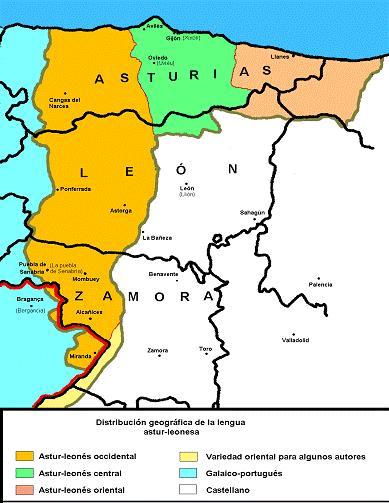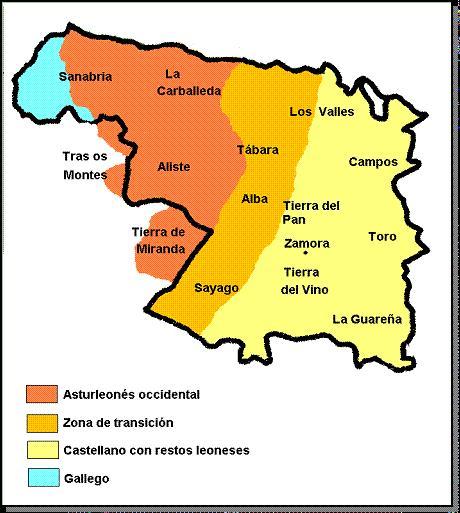As you can see, I really love Romance languages and I especially love Iberian Romance, probably because I understand, speak, read and even write Spanish pretty well. Hence, all of the Iberian Romance languages related to Spanish are pretty interesting to me.
I am finally figuring this show out. The announcer, who I previously thought was speaking some sort of Castillianized Asturian, is instead simply speaking Castillian Spanish. It is hard to understand because I cannot understand Castillian very well.
This clip is interesting. The announcer speaks Castillian all the way through it, but the 88 year old man speaks two languages. For most of the clip he speaks Castillian, but it is apparently so Leonized that I had the darnedest time understanding. So let us call his speech Leonese Castillian. At one point, the announcer asks him to speak something in Alistano and then he breaks into a short tale in Alistano. This starts at 3:54 and goes until 5:13. Then he goes back to his Leonese Castillian again. The Alistano was almost comical-sounding and I could barely get a single word of it. It almost sounded like a language from outer space.
If you can speak Spanish, see how well you can understand:
1. The Castillian of the announcer.
2. The strange Leonese Castillian of the old man.
3. The Alistano Leonese from 3:54 to 5:13.
Here are a couple of maps.

This shows the Asturian-Leonese language area at this time.
Western Asturian-Leonese is spoken in the orange area, except that Mirandese seems to be a separate language. In Leon, it is called Western Leonese and in Asturias, it is called Western Asturian. Western Asturian still has a lot of speakers. Western Leonese and Western Asturian do not seem to differ a lot. Western Leonese is the only Leonese that is in decent shape at all.
The green area is called Central Astur-Leonese. The Asturian standard is set in Central Asturias, which is where most of the speakers are. Leonese speakers dislike this standard because it is far from what they speak. This is one of the arguments they use to say that Leonese is a separate language from Asturian. As you can see, Central Leonese is in quite bad shape.
The brown area is Eastern Asturian-Leonese. The dialect is in quite bad shape. Even Eastern Asturian is not doing well. Eastern Leonese is almost dead, but it still has a few speakers.
The map shows the brown area extending into the western half of Cantabria, but this is not correct, as the lect spoken in Cantabria is Cantabrian, not Asturian, and it seems to be another language altogether. Cantabrian is frequently said to be dead, but that does not seem to be the case. There were monolingual speakers until very recently.
They had stubbornly refused to learn Castillian as they considered it to be an imposed language. In the mountains of Cantabria, as 2007, children were still showing up in school speaking a relatively pure Cantabrian. There were frequent complaints of teachers not being able to understand their students. As recently as 2003, a relatively pure Cantabrian could still be heard on a daily basis in the mountains. Cantabrian is best seen as an Asturian-Castillian transitional language.
Cantabrian seems to be together with Extremaduran in a single tongue, Cantabrian-Extremaduran. Both seem to represent far extensions of Eastern Leonese. In the case of Extremaduran, this is an Eastern Leonese dialect that got isolated down in Extremadura with the rapid expansion of Castillian. Extremaduran is intelligible with Cantabrian, but not with Central Asturian. This implies that we have two separate languages here.
The blue area on the map is Galician-Portuguese. The border between Galician and Portuguese is the red line on the far right of the picture. Galician is not well understood in Portugal, but people on the border speak a different lect that is intelligible on both sides of the border in the Minho and in Tras Os Montes. This lect looks Galician-Portuguese transitional, but it seems to be more Galician than Portuguese. In the Spanish part of the Minho, few residents speak Castillian because they have no use for it as all of their trade is across the border with Portugal. Spanish Minho speakers say that Minho Galician is not understood well outside of the Minho.
The yellow zone seems to be an area that was formerly Galician-speaking but has now gone over to Castillian. However, the Castillian in this area is heavily Leonized as you can see in the clip above. Castilian influence on Leonese was strongest in the south as this area is a lot less rugged so the language could penetrate easier. Up in the north, the Astur-Leonese area is very mountainous so Castillian had a harder time penetrating. Many towns still have only a poor road or even no road connecting them with the outside world.

Leonese in Zamora.
A better view of the languages of Zamora. As you can see, the far west of the province is indeed Galician speaking. The bright orange area is Leonese speaking, but Leonese here is in very bad shape and in many places, it is dying out. The yellow area is Castillian with heavy Leonese influence. The light area is some sort of a Leonese-Castillian transition zone. However, I would argue that Leonese is in terrible shape in the light orange area and is almost extinct in its purer form. Nevertheless, the speech here is quite Leonized.
Aliste on the map is where the Alistano speaker in the video is from. As you can see, it is at the far southern end of Leonese, and this is where Castillian influence was strongest.
